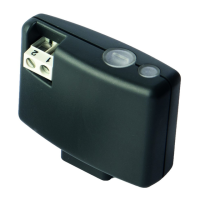13 - English
EN
4
OTHER FUNCTIONS
4.1 - Locking (or releasing) the management of the “Priority” function in the receiver
The“identicationcode”ofatransmitterwith“O-Code”and“O-Code/A”encodingsystemisaccompanied
by a number (from 0 to 3)thatallowsfordening(inthereceiver)itspriority level with respect to any other
transmitters with the same code. The “priority” is aimed at replacing and disabling the use of a lost or stolen
transmitter,withouthavingtogotothecustomer’ssystem.Useofthepriorityfunctionrequiresknowledgeof
the lost transmitter code and allows for keeping the same code and functions of the previous transmitter. The
lost transmitter can therefore be deactivated by simply updating the priority level of the new transmitter to the
next highest value.Whenthetransmitterisusedforthersttime,thereceiverwillmemorisethenew priority
level received and ignore any command sent by the lost or stolen transmitter, should it be used. The priority
can be changed through the O-Box programmer.
By default the receiver has the “Priority” function enabled, so the installer can exploit its potential applications.
Nonetheless, the O-Box programmer can be used to lock (or release) the receiver in managing this function.
4.2 - Enabling (or disabling) reception of the transmitter codes, modified with respect to the default code
The codes of transmitters with“FloR”,“FloR/A”,“O-Code”and“O-Code/A”encodingsystemcanbemodied
as desired using the O-Box or O-View programmer. By enabling or disabling this function, the receiver can
acceptorrefusethecommandofatransmitterwithmodiedidenticationcode(thedefaultsettingisON).
4.3 - Disabling (or enabling) the “variable part” (rolling code) of the code received
The receiver is programmed by default to only receive “rolling code”-type codes. The O-Box programmer,
however, can be used to programme the receiver so that it ignores the variable part (rolling code) of the code
received and considers it asa“xed”-typecode.

